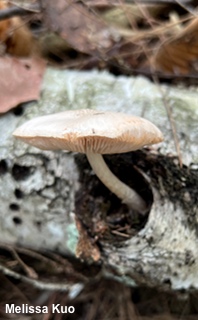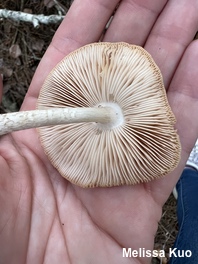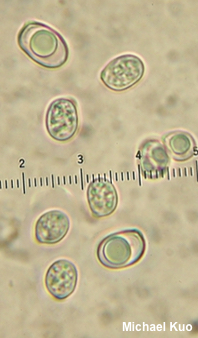| Major Groups > Gilled Mushrooms > Pink-Spored > Pluteus > Pluteus leucoborealis |

|
[ Basidiomycota > Agaricales > Pluteaceae > Pluteus . . . ] Pluteus leucoborealis by Michael Kuo, 31 August 2023 Described as a new species in 2014 (Justo et al.), Pluteus leucoborealis is a white (leuco) and northern (borealis) species found on the deadwood of birches and alders. Like other species of Pluteus it features gills that are free from the stem and a brownish pink spore print. Within the genus it can be separated on the basis of its range and habitat, along with its white cap (often adorned with brown fibrils and/or scales). Pluteus petasatus is usually larger and is more likely to appear in urban settings than in woods, but small woodland versions are not uncommon—and the species has even been collected on the deadwood of birch in northern ecosystems. Thus the most trustworthy way to separate Pluteus leucoborealis from Pluteus petasatus, short of DNA sequencing, is to measure spores; the spores of Pluteus leucoborealis are larger, especially in width. Description: Ecology: Saprobic on the deadwood of birches and alders; growing alone or gregariously on stumps and logs; summer and fall; originally described from Russia (Justo et al. 2014), with paratype collections from Mongolia, Alaska, Michigan, and New York; probably widespread in boreal and sub-boreal forests. The illustrated and described collection is from Michigan. Cap: 2–6 cm; convex, becoming broadly convex; dry; white; bald or brown-fibrillose, especially over the center; the margin not lined. Gills: Free from the stem; close; short-gills frequent; whitish at first, becoming pinkish. Stem: 3–6 cm long; 4–7 mm thick; tapered slightly to apex; scurfy; white with brown fibrils; basal mycelium white. Flesh: White; unchanging when sliced. Odor: Not distinctive, or slightly foul and reminiscent of coal tar. Spore Print: Brownish pink. Microscopic Features: Spores 7–9 x 5–6 µm; broadly ellipsoid; smooth; hyaline in KOH; inamyloid. Basidia 20–30 x 5–7.5 µm; clavate; 4-sterigmate. Pleurocystidia 65–80 x 15–24 µm; lageniform to subutriform or fusiform (intermediate cystidia); apex developing 2–4 prongs; smooth; walls 1–1.5 µm thick; hyaline in KOH. Cheilocystidia 30–50 x 10–20 µm; clavate; smooth; hyaline in KOH. Pileipellis a partially gelatinized cutis; elements 4–10 µm wide, smooth, hyaline to brownish in KOH. Clamp connections not found. REFERENCES: A. Justo, E. F. Malysheva, T. Bulyonkova & A. M. Minnis, 2014. (Justo et al., 2014.) Herb. Kuo 08132303. This site contains no information about the edibility or toxicity of mushrooms. |
© MushroomExpert.Com |
|
Cite this page as: Kuo, M. (2023, August). Pluteus leucoborealis. Retrieved from the MushroomExpert.Com Web site: http://www.mushroomexpert.com/pluteus_leucoborealis.html |



